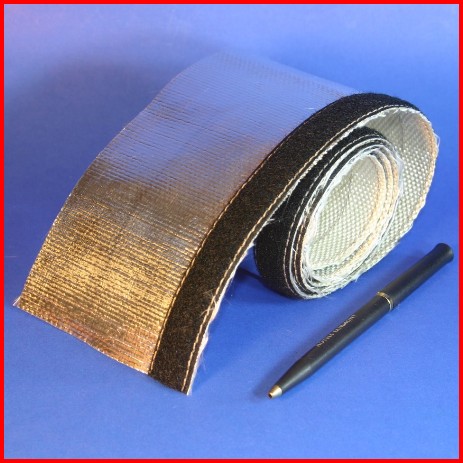Products > Sleeves > Heat Reflective
Aluminum Foil and Film Coated Fiberglass Heat Reflective Sleeve with Hook and Loop Closure
High Temperature, Heat & Flame Resistant, Radiant Heat Reflective Protection for Wire, Cables, Hoses and Tubing
450°F / 232°C Continuous Exposure / 1000°F / 537°C Peak Exposure
Two versions of this sleeve are available: One with an aluminum foil coating and the other with an aliminized film coating.
Both are coated onto fiberglass substrate fabric. The result is a high temperature, heat resistant and radiant heat reflective sleeve can be used to protect industrial wires, cables, hoses (hydraulics), piping and tubing from radiant heat sources such as glowing steel slab, liquid metal pour stream, infrared heaters and other similar sources.
With both versions, the fabric is slit into a tape, which then has hook and loop closure added to result in a sleeve that can be installed and removed at will.
With both versions, the fabric is slit into a tape, which then has hook and loop closure added to result in a sleeve that can be installed and removed at will.
This aluminized sleeve reflects more than 95% of the radiant energy that hits its surface, keeping the underlying cables, hoses and wires cool. Available in sizes from 1/2" through 12" ID. Larger sizes are available under special order. Two weights of fabric are used to make these sleeves: a 21oz and a 35oz. The 21oz material has better aluminum adhesion for applications requiring some flexing.
A four layer aluminum coated fabric is available. This fabric is more robust, but quite stiffer than a single layer aluminum coated fabric.
Generally, aluminum foil coated fiberglass is suitable for applications involving static hoses, cables and wires. For installation where continuous movement or flexing is involved, an aluminum coated film fiberglass is more suitable. Also available is a solid annular stainless steel sleeve.
The reduced continuous temperature limit of this material is due to the adhesive used to help bond the aluminum foil layer to the fabric. Notwithstanding the temperature limit, intense radiant heat can be reflected while still under the continuous temperature limit.




